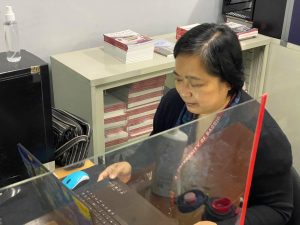A Webinar Series of UB RDC in Research Capability Building
In its continued pursuit of academic excellence and providing quality education, the University of Baguio once again conducted and hosted the Introduction, Methodology, Research, and Discussion (IMRaD) research writing and publication webinar. The webinar series aimed to help the participants and researchers familiarized with the parts of IMRaD format as an institutional guideline for research writing and publication.
The webinar was conducted on October 10, 2020, via Google meet and Facebook live. Dr. Aida Dapiawen, the Dean of the School of Teacher Education and Liberal Arts (STELA), gave the opening remarks and emphasized the importance of conducting research. Dr. Dapiawen pointed out that the use of the IMRaD format is also applied in graduate school as students are required to published an article including their theses and dissertations. After the opening remarks, Dr. Paddit discussed the statement of purpose and objectives of the webinar series highlighting how the participants would be able to apply it as a student, researcher or as a publisher.
The IMRaD format was discussed by Ms. Rhoda Carbonel, a faculty member of STELA, as the resource speaker. Ms. Carbonel highlighted the need for coherence in using the format since IMRaD is the most commonly used format in scientific article and journal writing and is used widely across most scientific and research fields. The use of the format has a certain degree of flexibility, depending on the guidelines of the institutions and publishers. IMRaD format is also an abridged version of the germanic writing style with the exclusions of the chapters in the template. UB has introduced the format in 2018 and constantly updated based on the comments and suggestions of the University’s Research Board members and School Research Anchorpersons. The migration to IMRaD format is to encourage more students, faculty and non-teaching staff to publish their research works in journals.
scientific article and journal writing and is used widely across most scientific and research fields. The use of the format has a certain degree of flexibility, depending on the guidelines of the institutions and publishers. IMRaD format is also an abridged version of the germanic writing style with the exclusions of the chapters in the template. UB has introduced the format in 2018 and constantly updated based on the comments and suggestions of the University’s Research Board members and School Research Anchorpersons. The migration to IMRaD format is to encourage more students, faculty and non-teaching staff to publish their research works in journals.
Dr. Isagani Paddit, UB Research Director, discussed what happens next to the completed researches and the process  of research publications. He talked about the general publishing cycle in the context of external publishers and UB’s publication policies and guidelines. UB maintains four major research publications to provide an avenue for students, faculty and non-teaching staff researches to be scholarly printed, disseminated and utilized by our stakeholders. The Research and Development Center publishes the Graduate School research journal in coordination with the Graduate School, the Catalyst as an undergraduate multidisciplinary research journal, the University Research journal for researchers conducted by faculty and non-teaching staff, and the Sukimat as peer-reviewed and referred journal. These publications are also provided on the UB website for easy access to everyone. UB also publishes researches in the national and international journals.
of research publications. He talked about the general publishing cycle in the context of external publishers and UB’s publication policies and guidelines. UB maintains four major research publications to provide an avenue for students, faculty and non-teaching staff researches to be scholarly printed, disseminated and utilized by our stakeholders. The Research and Development Center publishes the Graduate School research journal in coordination with the Graduate School, the Catalyst as an undergraduate multidisciplinary research journal, the University Research journal for researchers conducted by faculty and non-teaching staff, and the Sukimat as peer-reviewed and referred journal. These publications are also provided on the UB website for easy access to everyone. UB also publishes researches in the national and international journals.
The webinar was an overwhelming success and a testament that research is an integral part of education as the event was participated by more than 258 students, researchers and guest participants locally and internationally. The use of technology has allowed real-time collaborations and discussions with the participants.
The webinar ended with the closing remarks from Mr. Claven Erodias Jr., the school research anchorperson of STELA. Mr. Erodias Jr. synthesized what transpired throughout the program and thank the participants for their active participation. With the overwhelming success of the event, more and more people in the UB community, as well as its guest participants, are looking forward to the upcoming events and webinars by the UB Research and Development Center. | Ivy Lalio – RDC
